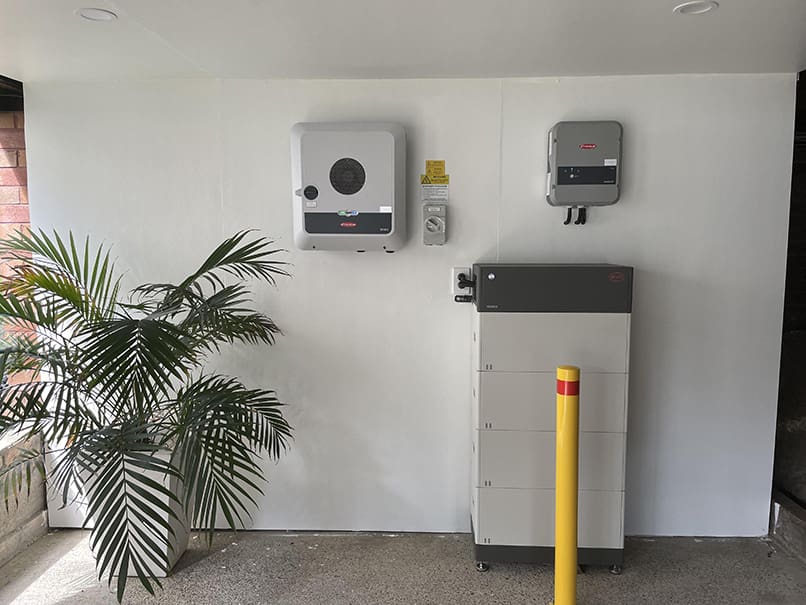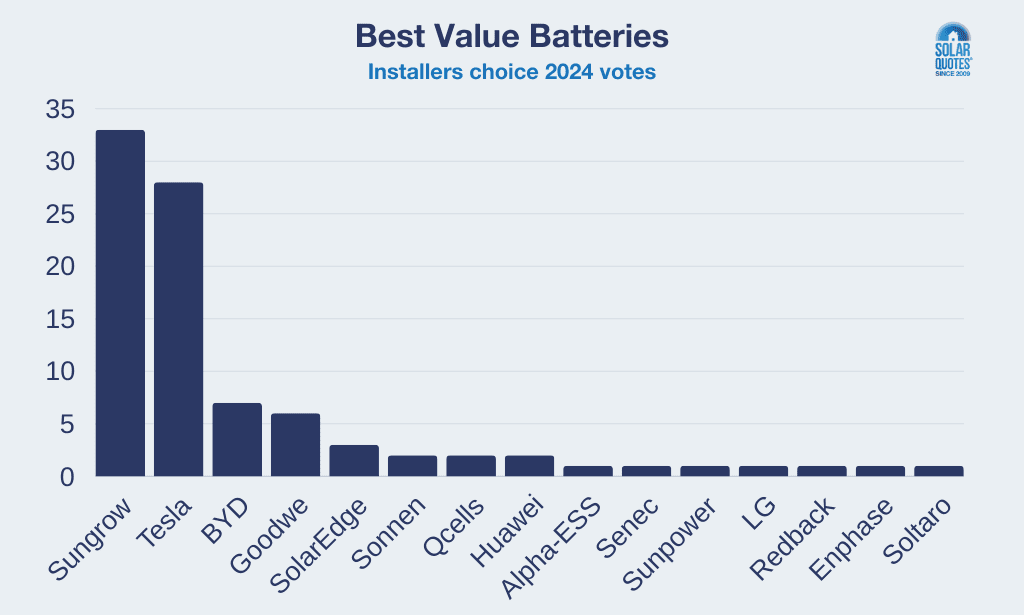What are the best home batteries in Australia in 2024?
I’ve once again reached out to our network of over 500 solar installers to get their take on the best battery brands in Australia.
I asked my installers three questions:
- Which battery brand would you choose if you were on a tight budget and every dollar counted?
- What battery brand would you choose for your home if money was no object?
- Which brand offers the best warranty support?
Around 100 installers found the time to respond. Here are the results:
Every Dollar Counts: The Best Value Home Battery Brands
If you want great value for money without going for an el-cheapo brand, these are the ones for you:
Bronze: BYD (8% of the vote)
Kicking off our “Every dollar counts” category is BYD, clinching the Bronze with 8% of the installer votes. A testament to reliability and value, BYD’s modular HVM and HVS batteries work great with Fronius Gen24 hybrid inverters.

A mint install of a Fronius Gen24 inverter and BYD battery, done by DJM Electrical
While BYD batteries may have a less-than-ideal 30-second change over time in a blackout, their performance and modular design have garnered praise from installers I trust.
Silver: Tesla (31% of the vote)
Rising to Silver from last year’s Bronze, many installers believe Tesla’s Powerwall 2 is the only game in town, even if you’re on a budget.

Me and my Powerwall 2 – going strong after 7 years!
The Powerwall 3, launching in Australia near the end of this year, promises an “all in one” solution with an included solar inverter. But if you have solar and want a battery now, there’s no point waiting for the Powerwall 3, as the Powerwall 2 has mostly the same specs (apart from the Powerwall 3’s 10kW output power) and is designed for retrofit.
Gold: Sungrow (36% of the vote)
Sungrow dominates the category for the second consecutive year, with a decisive 36% of the vote. Sungrow’s modular SBR HV battery system stands out for its affordability and comparable performance to pricier alternatives, providing a compelling choice for budget-conscious consumers. I even put one on my rental property.
I recently added a fifth 3.2 kWh module to my Sungrow battery, and the installation took about 30 minutes. So, unlike some cheaper rivals, Sungrow’s modular design is genuinely useful.

My Sungrow battery after the fifth module was retrofitted.
Money’s No Object: The Best Home Battery Brands
My installers think these are the best battery brands money can buy:
Bronze: Sungrow & SolarEdge (Tie with 10% of the vote each)
This year, Sungrow shares the Bronze with SolarEdge in the premium category, each securing 10% of the vote.

A SolarEdge 10 kWh home battery.
This highlights the diverse strengths of both brands, from Sungrow’s value proposition to SolarEdge’s DC-coupled battery, which seamlessly integrates with their Energy Hub inverter.
SolarQuotes employee Jono has a SolarEdge battery on his house which he’s chuffed with.
Silver: BYD (15% of the vote)
With its reliable, high-performance batteries, BYD retains the Silver position for another year, gathering 14% of the installer votes.
Gold: Tesla (53% of the vote)
For the fourth year running, Tesla takes home the Gold, underscoring its dominance in the premium solar battery market. There’s not much I can add here – their batteries “just work”, their app and control software are brilliant and constantly updated. The battery does everything you’d expect it to – installers and homeowners alike love them, even if they dislike Tesla’s increasingly nutty Technoking CEO.
Best Battery Support
The “Best after-sales support” category is crucial – if things go terribly wrong, batteries can catch fire, so you want to know you have a well-supported product.
Bronze: SolarEdge (5% of the vote)
With 5% of the vote, SolarEdge secures the Bronze position.
Silver: Sungrow (24% of the vote)
Sungrow’s commitment to customer service has been recognized with the Silver medal, thanks to 24% of the votes, highlighting their dedication to providing outstanding support.
Gold: Tesla (51% of the vote)
Demonstrating its all-round excellence, Tesla takes the Gold with an overwhelming 51% of the vote. This commendation from installers underscores their confidence in Tesla’s ability to provide unparalleled support.
Wrapping Up
Whether you prioritize cost, quality, or support, this year’s awards can guide your decision.
For a deeper dive into the specs and to compare these leading batteries, check out our detailed battery comparison table. Also, check out our up-to-date Top 10 solar battery brands list based on real Aussies’ reviews.
And remember, if you’re in the market for solar, batteries, or EV chargers, SolarQuotes is here to connect you with trusted installers to ensure you get the best possible solution for your home.








 RSS - Posts
RSS - Posts



I just wonder how to read the fact that Tesla had the best support. Does it mean that they needed more support/ faults compared to other brands. I have BYD installed and just works. After 18 months no need to call the installers which by the way went belly up (Keen 2b Green).
Powerwalls are often used in much more sophisticated ways than many other home batteries, and Tesla is there to support them. The stuff they can do remotely is impressive, and they often save a truck roll for the installer.
For example, Sean bought a 2nd Powerwall for his single-phase home to use Tesla’s time-based control on an advanced time-of-use tariff. The installer found the main breaker tripping when the Powerwalls started charging full-whack on the 8c solar sponge tariff. So Tesla remotely enabled load balancing so the Powerwall would throttle its charging based on the other loads so that it would never trip the breaker again.
“While BYD batteries may have a less-than-ideal 30-second change over time in a blackout,” this has nothing to do with the battery Finn, it comes down to the inverter it is connected to and how the inverter backup operates (EPS or UPS)
Hi Andrew,
Just to clarify, some people confuse EPS and UPS, the latter being pretty tightly regulated and something than none of the grid hybrids I’m aware of technically meet.
Sungrow for instance have a very tight changeover time, you’ll not notice a grid outage (and frankly that’s a trap if you don’t have some kind of alert to curtail consumption or drop your air conditioner off) However it’s not fast enough to be true UPS and if the system is exporting a decent amount of energy it will shut down and restart when the mains fail if the battery is close to fully charged.
SolarEdge & Fronius/BYD run parallel hybrid systems and “backup box” contactor arrangements so they have a 2 or 15 second delay when the mains fail (Fronius have shortened the time in a firmware update as far as I know)
Great point – totally agree. Almost all consumer BYD installations we see are a Fronius/BYD combo – so we’re trying to keep the advice simple. What combination do you use for a faster changeover on BYD batteries?
Hi Finn,
Thank you for this article. I was also excited to read that sodium batteries have moved from the lab to commercial production. (https://newatlas.com/energy/natron-sodium-ion-battery-production-startt/) (https://natron.energy/) Wondering if this is a worthwhile future blog topic? It raises lots of questions. Is the writing on the wall for lithium? Are shares in lithium mines headed for discounted stock? Have desalination plants now found a new use for their concentrated sea water output? How long will it be before home, car and power tool batteries are sodium? Will our fire brigades be decimated because of a lack of battery fires? Exciting times. Thank you again for your informative website and great team of experts.
Andrew
Hello Andrew, I am a consumer like you but what I read about the Salt batteries is that they are available now. BYD is producing small cars (Seagull) which are not available in Australia. However, the battery is small and can cover only about 250 km. I understand the reason is that the energy density in Salt battery is too low. The way I understand the lithium will still be used for more expensive cars and people looking for longer range. I understand new technology is coming still using Lithium as main ingredient. So I don’t think at this stage Lithium will be absolute.
Hi Ilian, thank you for your reply. I had not seen the Seagull, but I checked the BYD website and it looks great. Hopefully, we are not too far away from cheaper and safer battery storage technologies.
Best wishes for your day,
Andrew
Taking cheap shots at the Tesla CEO cheapens this site.